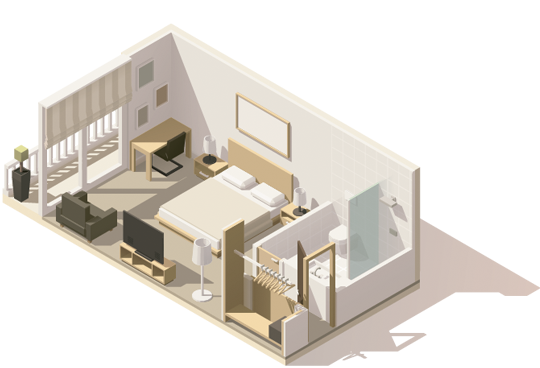

The 4 Step to building your very own dream home
Phase 1: Planning
- Get the paperwork like land title and other related documents ready before moving ahead with the construction.
- As per the requirement a building plan should be prepared by an enlisted architect/building surveyor. The specification of work will also be a part of it.
- The plan should adhere to the latest municipal guidelines and should be submitted to the municipal corporation/office, including the record of ownership, property tax payment receipt and the specified fee.
- If all the required formalities are fulfilled, it takes about 3 weeks from the date of submission for the plan to get approved.
- Once approved, the construction can be completed roughly within a year and a half.


Phase II: Budgeting
It is always wise to calculate the estimated expenses involved in constructing a house. In case of requirement of financial assistance, banks or other financial institutions may be contacted. Now a days, almost all the banks and many financial institutions extend financial assistance for building own home.
As per the current market rate of construction materials and associated labor costs, the approximate expenditure varies from ₹1200 to ₹2000 per sq. foot of built up area. While approximately 65% caters for the cost of building materials, 27% for the labour cost and 8% is sundry expenditure incurred during construction.
The above estimate does not include GST of land and other expenses for approval of the building plan by the municipality. A further break down of the charges is given below for guidance:
| PROCEDURE | PERCENTAGE |
|---|---|
| Design fee of building | 3 to 5% |
| Labour contractor (for labour only) | 6 to 10% |
| Layout of building and excavation of foundation | 2 to 4% |
| Cost of cement | 10 to 14% |
| Cost of steel rods | 6% |
| Cost of stone chips | 6% |
| Cost of bricks | 10% |
| Cost of sand | 5% |
| Doors and windows for the building | 7% |
| Shuttering & foam work | 4% |
| Flooring | 5% |
| Electrical work | 6% |
| Plumbing & sanitization | 6% |
| Painting work in wall, doors, windows etc | 10% |
| Septic tank reservoir, overhead tank | 7% |
| Misc. work | 7% |
A proposed house should preferably have the following accommodations:
- Drawing room/Living room
- Bedrooms (number & size will depend on the number of members in the family)
- Kitchen & Storeroom
- Puja room/Prayer room
- Bath & Toilet – it is advisable to have more than one bath & toilet
- Balcony/Verandah (As per requirement)

Phase III – Implementation
To implement a project one may either:
- Engage a suitable contractor and supply all the building materials by himself
- Or, engage a contractor who undertakes the responsibility of supplying building materials and labor to execute the construction to completion.
It is recommended that the owner should have full knowledge of and control over the construction materials used in the building. This will ensure quality construction at economical cost. Since the main structure of the house is made of R.C.C construction consisting of footing columns, grade beams, roof beams, roof slabs, lintel, sunshades, and staircase slabs etc., the quality of concrete mix and reinforcement steel should be supervised carefully. The R.C.C works have to be cured for at least 15 days from the next day of casting (curing means wetting the surface of the structure or wall with water at least twice a day). Similarly, all brick work, wall and ceiling plaster should be cured for atleast 7 days.

Now we come to a few guidelines for construction.
- The depth of the foundation should be at least 4′ from ground level. Depending on the soil quality after performing soil test, the depth of the foundation may be increased.
- Anti termite treatment
- Grade beams that function as the foundation of the walls should be constructed 1′ below ground level.
- The Plinth level should be at least 2′ but can be increased for areas prone to waterlogging.
- Lintel level above door window opening should be 7′ from plinth level.
- Window sill levels should be 2′-8″ from plinth level.
- Roof level should be at least 10′-0″ (min) above plinth level.
- Width of the staircase should be at least 3′-0″, while each step should be 6″ high and 10″ wide.
- Door and window openings should be decided as per convenience.

Stage IV – Execution
Hardwood timber planks/plywood for concrete columns, lintel beams or roof slabs, staircase slabs should be erected.
Cement concrete should be prepared using cement, sand, stone aggregate in the required proportion for the desired type of concrete to be used in footing, columns, lintel, roof beams, roof slabs, staircase slabs, etc. The quality of R.C.C. casting imparts strength to the structure.
Similarly the mortar should be prepared by mixing cement, sand and water in specified proportion for brickwork and plastering on the ceiling and walls.
Once the structure is ready and walls are constructed, the type of doors and windows to be selected and procured. In the market both Steel and Timber door/windows are available, a quick decision to be taken on type of material.
Bathroom floors and Dados should be with ceramic tiles. Other finishing works like painting, main flooring, bathroom fittings etc to be procured and installed depending on the budget.
Installation of a PVC storage tank or construction of an R.C.C. overhead reservoir having a capacity of 1000 litres or more should be done. The domestic water supply line from the municipality/corporation can be connected to the underground water reservoir.
Construction of a septic tank and a soak pit are two most essentials for disposal of toilet waste. Wastewater from the kitchen and bath can be discharged in the municipal drain nearby.
Completion of building
On completion of the building construction, a letter should be sent to the municipality/corporation informing about the completion of the construction as per the sanctioned plan and requesting a completion certificate.
After the internal wiring is done, the local electric supply authority should be approached for power connection. For distribution of water to the toilet, bath and kitchen – plumbing work should be carried out simultaneously.
Built-in facilities
Built in shelves and cupboards to save storage space and a loft above the toilets and passages can be created as a storage space.
Electrical wiring and plumbing could be concealed. Underground drains could be concealed and a trap at the wastewater outlet could also be installed to prevent insects from entering the house.

Roof waterproofing
It is preferable to have waterproofing treatment on the R.C.C roof slab to prevent rainwater seepage during heavy monsoons. The installation of rainwater drain pipes on the roof are also important.
In order to protect the structure, exposed doors and windows on the external walls should be provided with sunshades.

To allow rain water to flow away, the surface adjacent to the external walls, a ‘plinth protection’ should be provided with flat brick soling upto at least 20″ from the external wall with sufficient slope, outwards.
To prevent rain water from entering the wall’s foundation and causing dampness, the joints of soling bricks should be pointed with cement mortar.
Pre-construction soil treatment for prevention of white ants (Anti-termite treatment!)
Wide foundations are dug for the columns and grade beams. Mixing anti-termite chemicals in water and sprinkling it on the foundation and floor area at least thrice, within 5 days helps to eradicate termites.
Guidance of specialist
A complete set of work specifications for the construction of the building and estimated cost of the building including sanitary, plumbing, electrification, drainage, etc. should preferably be finalised In consultation with an architect/building surveyor.
